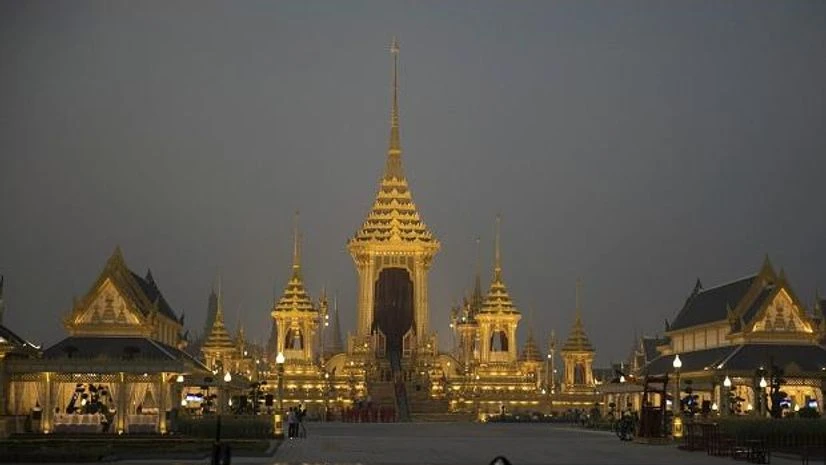A ceremony in an ornate throne hall on Thursday morning began the transfer of the remains of Thailand's King Bhumibol Adulyadej to his spectacular golden crematorium in the royal quarter of Bangkok after a year of mourning for the monarch Thais hailed as "Father."
Three separate and intensely solemn processions involving thousands of troops, a golden palanquin, a chariot and a royal gun carriage will move the royal urn representing Bhumibol's remains from the Dusit Maha Prasad Throne Hall to the crematorium.
The journey along a 2-kilometer (1.2-mile) route will take at least three hours and is being watched by tens of thousands of mourners dressed all in black and broadcast across the country.
More From This Section
Thousands of police and volunteers are on hand to ensure order and entry into the royal quarter, which has been tightly controlled to eliminate the faint possibility of protest against the monarchy or military government.
An activist had been detained earlier this week after writing on Facebook that he planned to wear red clothing on the day of Bhumibol's cremation, a color associated with support for political movements ousted in recent coups.
Before dawn today, 63-year-old Somnuk Yonsam-Ar sat on a paper mat amid a crowd of onlookers opposite the Grand Palace in Bangkok. Her granddaughter slept in her lap and her husband rested his head against a metal barrier. The family arrived the day before from the coastal province of Rayong, where they run a food stall.
Somnak waved a fan to cool herself, but said she was not tired.
"I feel blessed to be able to sit here, and be part of this," she said. "It's an important day for us."
The elaborate funeral for Bhumibol will take place over five days and began yesterday with his son, King Maha Vajiralongkorn, performing Buddhist merit-making rites before chanting monks and officials in immaculate white uniforms.
Bhumibol will be cremated today evening within a golden edifice built over a year and representing mystical Mount Meru, where Buddhist and Hindu gods are believed to dwell.
Deceased Thai royals have traditionally been kept upright in elaborate urns during official mourning. But Bhumibol, who spent much of his early life in the West, opted to be put in a coffin, with the urn placed next to it for devotional purposes.
Bhumibol's death at age 88 on October 13, 2016, after a reign of seven decades sparked a national outpouring of grief and a year of mourning. Millions of Thais visited the throne hall at Bangkok's Grand Palace to pay respects.
The adulation Bhumibol inspired was fostered by palace courtiers who worked to rebuild the prestige of a monarchy that lost its mystique and power when a 1932 coup ended centuries of absolute rule by Thai kings.
That effort built a semi-divine aura around Bhumibol, who was protected from criticism by a draconian lese mejeste law that mandates prison of up to 15 years for insulting senior royals.
But he was also genuinely respected for his development projects, personal modesty and as a symbol of stability in a nation frequently rocked by political turmoil, though his influence waned in his final years.
The funeral is by design an intensely somber event, but also rich in history and cultural and spiritual tradition.
Mourners are permitted to prostrate when royal processions pass but must not shout out "Long Live the King" or hold up cellphones to take photos or selfies.
Boonjerd Buasawat, a 61-year-old fruit vendor from the resort island of Phuket, had been waiting near the cremation site since midday yesterday and slept there overnight.
"I want to be here together with a group of people who dearly love their king," he said. "Our love won't die until we too pass and follow him.

)
